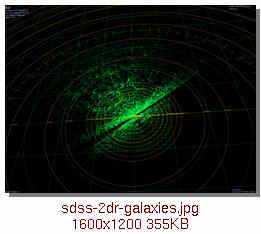SDSS = Sloan Digital Sky Survey.
It's a project to photograph about 1/4 of the sky with high precision.
See
http://www.sdss.org
They just published their second public "Data Release". It's about 6TB. I think they're about 1/3 done.
This Addon is a model consisting of glowing points in space, representing the locations of some 78,000 galaxies in deep space. You can see where there are large voids with no galaxies, as well as regions of high density, forming "walls". Over very large volumes, galaxies are arranged as if they were on the surfaces of bubbles.
Unfortunately, the precision of the redshift values that they've published is rather low. It needs to be at least 10x better: if you look closely at the model, you'll see that the galaxies form circles centered on the sun. I've written to their helpdesk at FNAL (Fermi National Accelerator Laboratory, one of the primary members of the collaboration) to ask if better values are available. The errors that they quote imply that there are.
(Added slightly later)
For comparison, you might want to look at the model of the equivalent 2dF survey, which looked in somewhat different directions than the Sloan survey is looking. It's available on my
Catalogs Web page, along with some others. I've used different colors for the models. The CMOD model files are plain text files, though, so you can edit them to use whatever color scheme you want.

